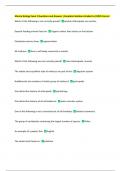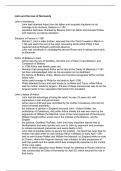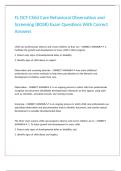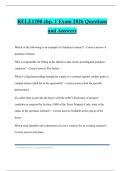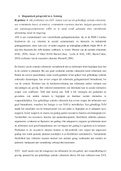2MAR 2021-2022
EXAM: UNDERSTANDING GLOBAL CULTURES PPT’S
1. Rules of the social game
a) Your identity
To understand culture, you need to know who you are (your DNA, feelings, experiences …)
= your cultural makeup
3 roles: PERSONAL (character) // SOCIAL (role in school/family) // CULTURAL (society)
• Public features: things you can see visually (observations can reveal something)
• Personal features: things you learn by asking questions, listening …
• Psychological features: sincere feelings, opinions, how we see others …
b) What is culture?
= the cultural programming of the mind distinguishing a group or a category of people
from others
= the right way of doing something, values of people
How do we detect culture?
The way information is being interpreted:
• What you see (55%)
• What you hear (by tone of voice) (38%)
• What you read (7%)
How to get action with culture?
• Visuals = large awareness (60-65%)
• Visuals + tone of voice = adaptation
• Visuals + tone of voice + right words = cultural action (accepting + taking part)
Types of culture:
• Material culture: products made by man, such as clothing, tools …
• Subjective culture: intangible part of culture, including ideas, attitudes, beliefs …
The cultural iceberg: we can only see part of culture, the rest is hidden
• 30% = what we do (visible) = way of life example: clothing
• 40% = what we think (ideology) = philosophy
• 30% = what we feel (hidden) = desires or attitudes example: beauty values
c) Culture as mental programming: HOFSTEDE
Common problems -> different minds
• Although the variety in people’s minds is enormous, there is a structure in this variety
= basis for mutual understanding
The software of the mind:
Every person has its own pattern of thinking, feeling and potential acting
-> we can see a pattern = software of the mind
We can learn a pattern, but we can also unlearn it to learn a new one
• A person’s behavior is only predetermined by his/her mental programs
• Sources of mental programs lie in social environments (life experiences)
• We learn a pattern everywhere: family -> neighborhood -> school -> work -> …
Culture – narrow and broader (customary: mental software = culture)
• Narrow sense:
In Western language ‘culture’ means ‘civilization’ or ‘refinement of the mind’
= education, art, literature …
• Broader sense:
In social anthropology ‘culture’ means all patterns of thinking, feeling and acting
1
, 2MAR 2021-2022
3 levels of uniqueness in mental programming (HOFSTEDE)
Culture is about the unwritten rules of the social game
Culture = collective programming of the mind that distinguishes the members of one group
or category of people from others
Personality = someone’s personal set of mental
programs that isn’t shared with any other human being
(based on traits, inherited within the
individual’s set of genes + partly learned)
Culture = learned, derives from social environment
Human nature = what all human beings have in
common = the “operating system” that determines our
physical and basic psychological functioning (the ability
to feel fear, anger, love, joy, sadness …)
! PITFALL !
Cultural traits have often been attributed to heredity (erfelijkheid)
-> role of heredity is exaggerated in pseudo theories of race
Analogy culture = onion diagram:
• Symbols = consist of words, gestures, pictures or objects that carry a
particular meaning that is recognized as such only by those who share the
culture, understood only by those who know the culture and take part
• Heroes = all persons (dead or alive) in real or virtual, who are
considered as being very important in that culture
• Rituals = group activities that are technically not necessary to achieve
your goal (accepting cultures), but are socially essential in a culture (the
way language is used in text and talk)
• Values = the heart, soul and core of every culture (select certain
states/facts as good or bad, do’s and don’ts)
• Practices = symbols, heroes and rituals are collected in practices
(clearly visual for every extern, but the cultural meaning is invisible)
Concepts of values:
• Evil ó good
• Dangerous ó safe
• Forbidden ó permitted
• Decent ó indecent
Measuring values:
§ Desirable: what the world think is best (absolute)
§ Desired: what an individual thinks is good/bad
§ Norms: what a group thinks is right
Case: French person explains onion diagram
o Rituals = collective activities (not actually needed to achieve a goal)
Examples: most Asians shower in the evening, Europeans in the morning, German
people often shake hands, the way you serve tea …
= ways of greeting and paying respect to others, social and religious ceremonies
salutations in a letter …
2
, 2MAR 2021-2022
o Heroes = a person, real or imaginary who possess characteristics which are highly
prized in a culture (who serves as a model)
Example: in Nantes (FR) the hero is Jules Vernes (writer) -> many cultural attractions +
strong influence on the identity of the city
o Symbols = words in a language, pictures, objects, cultural monuments, flags,
architecture, traditional clothing, hairstyles, food …
Examples: Eiffel Tower in Paris, French gastronomy …
= nowadays symbols appear as brands usually according to fashion, but sometimes
embedded in culture
Examples: Apple in California, Mini in the UK, Chanel in France …
o Values = the heart, soul and core of every culture (learned early in life, often
unaware)
= Outsiders can’t see them directly (look at symbols, heroes and rituals to guess what
the values are) – describing or discussing them is difficult
These are the basis of a culture, the most important things embedded in a culture
d) Morality:
You can link morality to the ‘value’ part of the onion -> because it’s about right and wrong
Values and the moral circle:
• Moral circle = the ones who are members of our group (mental programs are adapted
to life in a moral circle)
• We don’t use the same moral rules for members than for others
• We are pride of our group when things go well, ashamed when the group fails
Group-related emotions are universal: sports, song festivals, and TV shows
The expanding circle:
Moral history of humankind:
Over the course of human history, people have expanded the circle of beings whose
interests they are willing to value similarly to their own. Originally that circle would have
been self, family and tribe, but over time it grew to encompass all other humans
-> let’s not exclude anyone!
= process of ethics as an expanding circle
-> search for unknown territory: maybe we exclude groups from moral discourse
To overcome global injustice Peter Singer pleads for a form of world governance (wereld
bestuur)
How can a world community regulate its affairs (values; protection of human rights …) but
ultimately go beyond that to the protection of all human beings and the global environment
Boundaries of the moral circle:
• Philosophy, spirituality and religion are ways of sorting out the difference between good
and bad, for 2.500 years, philosophers in the East and West have taught the Golden Rule:
“Do to others as you would wish them to do to you”
• Nations and religions can come into competition if they both attempt to set up a society-
level moral circle in the same country
• Societies and religions often expand the moral circle, to consider all humans as belonging
to a single moral community (-> Universal Declaration of Human Rights …)
3
EXAM: UNDERSTANDING GLOBAL CULTURES PPT’S
1. Rules of the social game
a) Your identity
To understand culture, you need to know who you are (your DNA, feelings, experiences …)
= your cultural makeup
3 roles: PERSONAL (character) // SOCIAL (role in school/family) // CULTURAL (society)
• Public features: things you can see visually (observations can reveal something)
• Personal features: things you learn by asking questions, listening …
• Psychological features: sincere feelings, opinions, how we see others …
b) What is culture?
= the cultural programming of the mind distinguishing a group or a category of people
from others
= the right way of doing something, values of people
How do we detect culture?
The way information is being interpreted:
• What you see (55%)
• What you hear (by tone of voice) (38%)
• What you read (7%)
How to get action with culture?
• Visuals = large awareness (60-65%)
• Visuals + tone of voice = adaptation
• Visuals + tone of voice + right words = cultural action (accepting + taking part)
Types of culture:
• Material culture: products made by man, such as clothing, tools …
• Subjective culture: intangible part of culture, including ideas, attitudes, beliefs …
The cultural iceberg: we can only see part of culture, the rest is hidden
• 30% = what we do (visible) = way of life example: clothing
• 40% = what we think (ideology) = philosophy
• 30% = what we feel (hidden) = desires or attitudes example: beauty values
c) Culture as mental programming: HOFSTEDE
Common problems -> different minds
• Although the variety in people’s minds is enormous, there is a structure in this variety
= basis for mutual understanding
The software of the mind:
Every person has its own pattern of thinking, feeling and potential acting
-> we can see a pattern = software of the mind
We can learn a pattern, but we can also unlearn it to learn a new one
• A person’s behavior is only predetermined by his/her mental programs
• Sources of mental programs lie in social environments (life experiences)
• We learn a pattern everywhere: family -> neighborhood -> school -> work -> …
Culture – narrow and broader (customary: mental software = culture)
• Narrow sense:
In Western language ‘culture’ means ‘civilization’ or ‘refinement of the mind’
= education, art, literature …
• Broader sense:
In social anthropology ‘culture’ means all patterns of thinking, feeling and acting
1
, 2MAR 2021-2022
3 levels of uniqueness in mental programming (HOFSTEDE)
Culture is about the unwritten rules of the social game
Culture = collective programming of the mind that distinguishes the members of one group
or category of people from others
Personality = someone’s personal set of mental
programs that isn’t shared with any other human being
(based on traits, inherited within the
individual’s set of genes + partly learned)
Culture = learned, derives from social environment
Human nature = what all human beings have in
common = the “operating system” that determines our
physical and basic psychological functioning (the ability
to feel fear, anger, love, joy, sadness …)
! PITFALL !
Cultural traits have often been attributed to heredity (erfelijkheid)
-> role of heredity is exaggerated in pseudo theories of race
Analogy culture = onion diagram:
• Symbols = consist of words, gestures, pictures or objects that carry a
particular meaning that is recognized as such only by those who share the
culture, understood only by those who know the culture and take part
• Heroes = all persons (dead or alive) in real or virtual, who are
considered as being very important in that culture
• Rituals = group activities that are technically not necessary to achieve
your goal (accepting cultures), but are socially essential in a culture (the
way language is used in text and talk)
• Values = the heart, soul and core of every culture (select certain
states/facts as good or bad, do’s and don’ts)
• Practices = symbols, heroes and rituals are collected in practices
(clearly visual for every extern, but the cultural meaning is invisible)
Concepts of values:
• Evil ó good
• Dangerous ó safe
• Forbidden ó permitted
• Decent ó indecent
Measuring values:
§ Desirable: what the world think is best (absolute)
§ Desired: what an individual thinks is good/bad
§ Norms: what a group thinks is right
Case: French person explains onion diagram
o Rituals = collective activities (not actually needed to achieve a goal)
Examples: most Asians shower in the evening, Europeans in the morning, German
people often shake hands, the way you serve tea …
= ways of greeting and paying respect to others, social and religious ceremonies
salutations in a letter …
2
, 2MAR 2021-2022
o Heroes = a person, real or imaginary who possess characteristics which are highly
prized in a culture (who serves as a model)
Example: in Nantes (FR) the hero is Jules Vernes (writer) -> many cultural attractions +
strong influence on the identity of the city
o Symbols = words in a language, pictures, objects, cultural monuments, flags,
architecture, traditional clothing, hairstyles, food …
Examples: Eiffel Tower in Paris, French gastronomy …
= nowadays symbols appear as brands usually according to fashion, but sometimes
embedded in culture
Examples: Apple in California, Mini in the UK, Chanel in France …
o Values = the heart, soul and core of every culture (learned early in life, often
unaware)
= Outsiders can’t see them directly (look at symbols, heroes and rituals to guess what
the values are) – describing or discussing them is difficult
These are the basis of a culture, the most important things embedded in a culture
d) Morality:
You can link morality to the ‘value’ part of the onion -> because it’s about right and wrong
Values and the moral circle:
• Moral circle = the ones who are members of our group (mental programs are adapted
to life in a moral circle)
• We don’t use the same moral rules for members than for others
• We are pride of our group when things go well, ashamed when the group fails
Group-related emotions are universal: sports, song festivals, and TV shows
The expanding circle:
Moral history of humankind:
Over the course of human history, people have expanded the circle of beings whose
interests they are willing to value similarly to their own. Originally that circle would have
been self, family and tribe, but over time it grew to encompass all other humans
-> let’s not exclude anyone!
= process of ethics as an expanding circle
-> search for unknown territory: maybe we exclude groups from moral discourse
To overcome global injustice Peter Singer pleads for a form of world governance (wereld
bestuur)
How can a world community regulate its affairs (values; protection of human rights …) but
ultimately go beyond that to the protection of all human beings and the global environment
Boundaries of the moral circle:
• Philosophy, spirituality and religion are ways of sorting out the difference between good
and bad, for 2.500 years, philosophers in the East and West have taught the Golden Rule:
“Do to others as you would wish them to do to you”
• Nations and religions can come into competition if they both attempt to set up a society-
level moral circle in the same country
• Societies and religions often expand the moral circle, to consider all humans as belonging
to a single moral community (-> Universal Declaration of Human Rights …)
3

